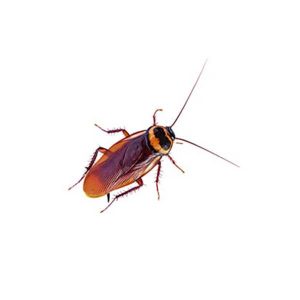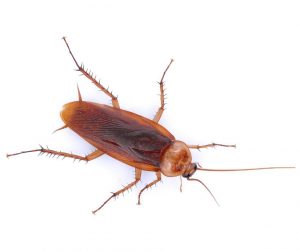Surinam Cockroaches in Georgia
The Surinam cockroach is a burrowing species commonly found in warm, humid environments like greenhouses, gardens, and potted plants. Unlike other roaches, they primarily live outdoors, feeding on decaying plant matter. Though they rarely invade homes, they can cause damage to plants and are sometimes brought indoors accidentally with infested soil. Surinam roaches do not need males to reproduce. This means the female can reproduce asexually through a process called parthenogenesis (when the female can have babies without the need of sperm/fertilization).
Surinam Cockroach Facts and Identification
What Do Surinam Cockroaches Look Like?
Surinam roaches have black or brown bodies and olive or brown almost transparent-looking leathery wings. The area directly located behind the head (pronotum) is very shiny and black or dark brown in coloration. This is one of the reasons these roaches are oftentimes confused with smokybrown and oriental cockroaches. Surinam roaches are not more than about 1 inch in length.
Unlike other roaches, they primarily live outdoors, feeding on decaying plant matter. They are known for reproducing through parthenogenesis, meaning females can reproduce without males. Though they rarely invade homes, they can cause damage to plants and are sometimes brought indoors accidentally with infested soil. Proper plant care and inspection can help prevent infestations.
Signs of a Surinam Cockroach Infestation
Signs of a Surinam cockroach infestation include finding these insects around potted plants, mulch, and damp garden areas. Indoors, look for them near houseplants or in moist, dark corners of basements. They may leave behind fecal pellets, which resemble coarse pepper grains, and shed skins. An infestation may also be indicated by a noticeable increase in cockroach sightings, especially during nighttime.
Habitat, Diet, Life Cycle & Behaviors
Where Do Surinam Cockroaches Live?
Surinam roaches are most commonly found outside. Unlike some other types of cockroaches in Georgia, they are not home-infesting roaches. They like warm damp soil, such as that found in a greenhouse, which is what earned them the common name “greenhouse roaches.” Outside, these roaches can be found under soil, rocks, leaf piles, debris, woodpiles, etc. The most common way these roaches get inside is when you bring in potted plants for the winter. They are usually hiding down in the soil and emerge when brought into the warm home because they think the weather is warming up. These roaches can also find their way inside through unsealed entry points around the home.
Diet
Surinam cockroaches primarily feed on decaying plant material, including leaves, mulch, and compost. Their diet consists of organic matter found in garden soil and under debris. They play a role in breaking down plant matter, contributing to nutrient recycling in their natural habitat.
Life Cycle
The life cycle of Surinam cockroaches includes these stages:
- Eggs: Females produce egg cases (oothecae) containing around 30 eggs each, deposited in moist, protected environments.
- Nymphs: Eggs hatch into nymphs, which resemble miniature adults but lack wings. Nymphs molt several times as they grow.
- Adults: Mature nymphs become adults with fully developed wings. Only males can fly. Adults reproduce both sexually and asexually, with asexual reproduction involving the production of oothecae without mating.
The entire life cycle, from egg to adult, can take several months, depending on environmental conditions.
Behaviors
These roaches burrow into the soil and feed on plant roots or stems. They are pests in gardens, greenhouses, and lawns. Indoors, they should not be a major problem. If these roaches Surinam cockroaches do happen to find their way into your home they will not survive for very long. They need warmth and high humidity for survival. They may make their way to bathrooms in search of moisture, but even in the bathroom, they will not survive. They are usually nocturnal, so you may not see them until they are dead somewhere in the home. Always contact your local pest control experts for assistance in getting rid of roaches.
Are Surinam Cockroaches Dangerous?
Surinam cockroaches are generally not dangerous to humans. They do not bite and are not known to spread diseases. However, their presence can be a nuisance, especially if they infest indoor potted plants or damp areas. They can also cause allergic reactions in sensitive individuals. For help with getting rid of Surinam cockroaches, contact your local cockroach pest control company.
How To Get Rid of Surinam Cockroaches
To get rid of Surinam roaches, we recommend targeted treatments such as insecticide sprays and baits in areas where they are active, like potted plants and damp corners. Removing infested soil and debris can help. For severe infestations, professional pest control may be necessary to ensure thorough elimination. Pest control experts like Active Pest Control can apply insecticides and treatments to safely remove the pests from your home, with specialist knowledge, including how to get rid of cockroaches from air vents.
Surinam Cockroach Prevention Tips
To prevent Surinam cockroaches, avoid overwatering potted plants and ensure proper drainage. Regularly inspect and clean garden soil and mulch. Maintain dry, clean indoor environments free of organic debris and seal cracks and gaps in your home to block entry points. If you notice signs of an infestation or persistent problems despite preventive measures, it’s crucial to know when to call an exterminator for cockroaches for effective treatment.
Our team of cockroach pest control experts understands how distressing an oriental cockroach infestation can be. We are proud to provide our Georgia community with quick, effective, and long-lasting cockroach control services year-round.
Need help with pest control?
Ready for your FREE quote?
Fill out the form below and we’ll be in touch!
*During normal business hours. After hours inquiries will be returned the next business day.
Surinam Cockroach FAQs
Do Surinam Roaches Infest Homes?
Surinam cockroaches rarely infest homes, as they prefer moist outdoor environments like gardens and potted plants. However, they can enter homes when brought in with soil or plants. Infestations indoors are uncommon but may occur in humid areas like basements or near houseplants.
Where Are You Most Likely To Find a Surinam Cockroach?
Surinam cockroaches are most commonly found outdoors in moist environments like gardens, potted plants, mulch, and under debris. They thrive in warm, humid climates, making them prevalent in southern U.S. states. Indoors, they may be found in potted plants or damp basements.
What Is the Behavior of the Surinam Cockroach?
Surinam cockroaches are primarily nocturnal and prefer moist, soil-rich environments like gardens and mulch. Unlike many cockroach species, they are not strong fliers. Females reproduce asexually, rapidly increasing populations. They hide during the day under plant debris, emerging at night to feed on decaying plant material.
Where Did the Surinam Cockroach Come From?
Despite its name, the Surinam cockroach likely originated in Southeast Asia but has spread globally through human activity, particularly via the plant trade. It thrives in tropical and subtropical climates, making it common in the southern U.S. It primarily invades homes through potted plants and garden soil.





